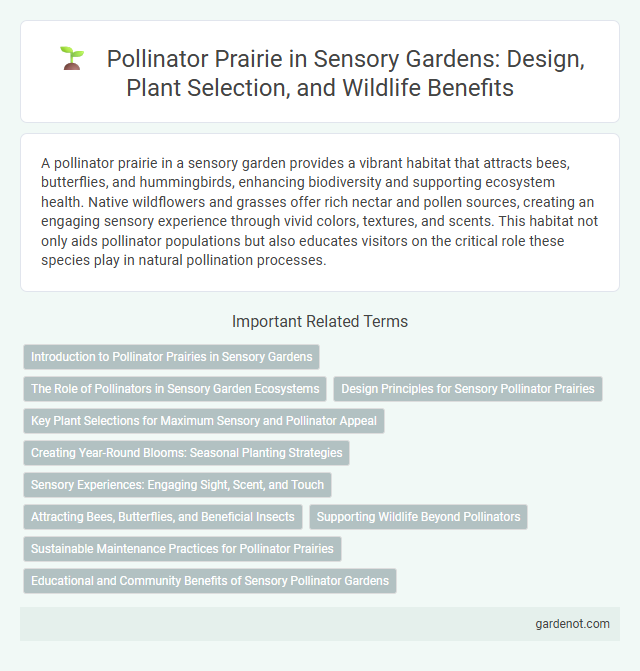A pollinator prairie in a sensory garden provides a vibrant habitat that attracts bees, butterflies, and hummingbirds, enhancing biodiversity and supporting ecosystem health. Native wildflowers and grasses offer rich nectar and pollen sources, creating an engaging sensory experience through vivid colors, textures, and scents. This habitat not only aids pollinator populations but also educates visitors on the critical role these species play in natural pollination processes.
Introduction to Pollinator Prairies in Sensory Gardens
Pollinator prairies in sensory gardens serve as vibrant ecosystems designed to attract bees, butterflies, and other pollinators essential for plant reproduction and biodiversity. These prairies feature native wildflowers and grasses that offer nectar, pollen, and habitat, supporting a variety of insect species crucial for ecological balance. Incorporating pollinator prairies enhances sensory experiences through vivid colors, diverse textures, and dynamic wildlife activity, promoting environmental awareness and conservation.
The Role of Pollinators in Sensory Garden Ecosystems
Pollinators such as bees, butterflies, and hummingbirds play a crucial role in sensory garden ecosystems by facilitating the reproduction of flowering plants through effective pollen transfer. Their activity enhances plant diversity and supports the growth of aromatic and visually stimulating flora, which intensifies sensory experiences. Incorporating native pollinator-friendly plants in a pollinator prairie creates a thriving habitat that sustains biodiversity and promotes ecological balance within sensory gardens.
Design Principles for Sensory Pollinator Prairies
Design principles for sensory pollinator prairies emphasize diverse native plant selection to support butterflies, bees, and hummingbirds, enhancing ecological balance and sensory stimulation. Incorporating varied textures, colors, and blooming periods maximizes sensory engagement while ensuring continuous forage for pollinators. Strategic layout includes shelter zones and water sources to create habitat complexity, promoting pollinator health and visitor interaction.
Key Plant Selections for Maximum Sensory and Pollinator Appeal
Key plant selections for a pollinator prairie include native wildflowers like milkweed, coneflowers, and black-eyed Susans, which maximize nectar and pollen availability for bees, butterflies, and hummingbirds. Incorporating diverse flowering species ensures continuous bloom throughout the growing season, enhancing sensory appeal with vibrant colors and varied textures. Grasses such as little bluestem provide essential habitat structure, supporting pollinator diversity and creating a dynamic, tactile environment.
Creating Year-Round Blooms: Seasonal Planting Strategies
Pollinator prairies thrive by incorporating seasonal planting strategies that ensure continuous blooms throughout the year, attracting bees, butterflies, and other essential pollinators. Selecting native perennials like coneflowers, black-eyed Susans, and milkweed provides staggered flowering periods from spring through fall, supporting diverse pollinator species during critical foraging times. Integrating early-blooming bulbs and late-season asters extends nectar availability, maximizing habitat value and contributing to a vibrant, sustainable sensory garden ecosystem.
Sensory Experiences: Engaging Sight, Scent, and Touch
Pollinator prairies offer a rich sensory experience by stimulating sight with vibrant wildflowers and diverse plant colors that attract bees, butterflies, and hummingbirds. The scent of native blooms like coneflowers and milkweed enhances the garden's aromatic landscape, engaging the olfactory senses. Textural variation from soft petals to coarse leaves invites tactile exploration, making the prairie an immersive environment for visitors of all ages.
Attracting Bees, Butterflies, and Beneficial Insects
Pollinator prairies create vibrant habitats rich in native flowering plants that attract bees, butterflies, and beneficial insects essential for ecosystem health. These prairies offer diverse nectar sources and shelter, supporting vital pollination processes and improving biodiversity. Incorporating pollinator-friendly species like milkweed, coneflowers, and goldenrod ensures continuous blooming and sustains pollinator populations year-round.
Supporting Wildlife Beyond Pollinators
Pollinator prairies enhance biodiversity by providing essential habitat and food sources for a variety of wildlife beyond just pollinators. Native grasses and flowering plants offer shelter and breeding grounds for birds, small mammals, and beneficial insects, contributing to ecosystem resilience. These prairies also improve soil health and water retention, supporting a more balanced and thriving environment within the sensory garden.
Sustainable Maintenance Practices for Pollinator Prairies
Pollinator prairies thrive through sustainable maintenance practices that emphasize minimal disturbance and native plant diversity, which support essential pollinator species such as bees, butterflies, and hummingbirds. Techniques like periodic controlled burns, selective mowing, and organic weed management enhance habitat health while promoting soil fertility and preventing invasive species. Maintaining pollinator prairies ensures ecological balance and long-term resilience, contributing to biodiversity and ecosystem services vital for agricultural productivity and environmental sustainability.
Educational and Community Benefits of Sensory Pollinator Gardens
Sensory pollinator gardens serve as dynamic educational tools, offering hands-on learning opportunities about native plant species, pollination processes, and biodiversity conservation. These gardens foster community engagement by creating inclusive, multisensory environments that support mental well-being, social interaction, and environmental stewardship among diverse age groups. By enhancing local ecosystems, sensory pollinator gardens contribute to pollinator habitat restoration, promoting sustainable urban agriculture and ecological resilience.
Pollinator prairie Infographic

 gardenot.com
gardenot.com